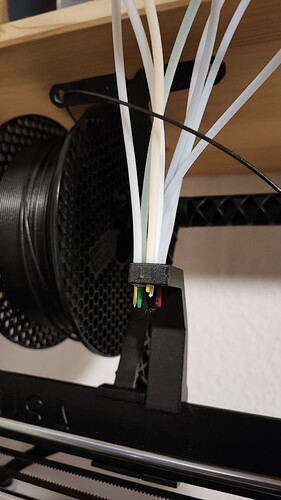Edit: Holy hell, that took me almost an hour to write. Maybe don’t worry about reading it unless you’re interested in a slightly rambling explanation of the basics of EMC/noise.
No ‘big inductor’ is truly ever just a big inductor. There can also be a lot of inter-winding capacitance so I think you’ll be surprised just how ‘non inductive’ that coil is at even modest frequencies, given that it’s basically wound as a DC inductor.
It also depends on what you mean by there being no high frequency ‘through’. Probably not a whole lot of particularly high order frequency components in the current, but there normally wouldn’t be anyway. There will definitely a lot of high frequency voltage, given that the entire switching drive voltage will be appearing on the terminals. There will likely be quite high frequency ringing on the switching nodes (which is all of them in this case), which will then in turn lead to high frequency currents through the motor and coil parasitic elements.
Depending on the capacitor, this thing KILLS switching elements. That capacitor leads to a big pulse of current during switching, which is when the elements are going from off to on, so usually corresponds to the switch being in the linear state during transitions. Typically if you’re adding capacitance here, you’d be doing so with a resistor in the way to limit that current, or an inductor, which means that you then have a tuned element that needs to match the frequencies being suppressed. That’s basically called a snubber, at that point.
Adding inductance will reduce ripple current, which I doubt is the issue here, but it won’t likely do much more. Even if you added the same inductance as the motor (which is a pretty big inductor to add), then all it’d do is halve the high frequency component, if considered as an ideal component. In reality, maybe not even that. It may change the frequency somewhat, but unless you’ve got a clear starting and target point, just changing things isn’t usually considered a win. Maybe in this case it may work, though.
I don’t think you’re likely to hit a high Q resonance like that. More likely is that all systems ring on the switching edges and it’s some other aspect that makes it more of a problem for some people. Component tolerances, operating temp, cable routing, other background noise sources combining in the same bands, something like that.
You’re not that far off with all this reasoning at all, it’s all ‘close but not quite’, which is impressive.
EMC control ferrites/beads and inductors are similar on the surface but extremely different in behaviour/application. An inductor you typically want to be predictable in its complex impedance over a given and relatively low frequency range. A ferrite (which is an ambiguous name in itself, because most inductors still use a ferrite core) when used for EMC is typically an extremely non-linear component, with minimal impedance in the pass band and a rapidly increasing inductance/resistance in the higher frequency ranges where you want EMC control. As such, the behaviour will be very different.
So, the thing with EMC, especially at lower frequencies and ‘near field’ considerations, is that you can get either E field or H field coupling, which is electric field (voltage) and magnetic field (current). At higher frequencies or in the far field then you can look at it more as transmission/reception and things being antennas, but here it can be thought of more directly as those two fields. A differential voltage between 2 conductive parts will have an electric field between them, also between those parts and ground/earth. A current flowing in a conductor will have a magnetic field surrounding it. Both of those fields will couple into adjacent elements and induce what are usually unwanted currents/voltages in response. That’s basically all that ‘noise’ and EMC issues are, fundamentally.
In this case, the motor controllers are switching at around 40kHz into what is basically a relatively high value inductor in order to maintain a DC current. So in terms of current, we’ll have the DC component and then also a much lower magnitude 40kHz ripple component on top of that which will look like a triangle wave. Ignoring any of the parasitics, that will give us just the DC component of the magnetic field and then whatever the much lower magnitude triangle wave decomposes to. That DC component will also be varying with movement, but the step rates are slow enough that I’d still just consider it DC.
Then there are the switching nodes. The output terminals of the motor controller can only ever be at Vmot or 0V, but they will be switching between those two points twice for every 40kHz cycle. So each motor driver output, and consequently the wire out to the motor, will look like a square wave between Vmot and 0V at varying pulse width, but also with the edges of that square wave being anywhere between 10ns and 100ns, depending on the device. Those fast switching edges decompose into some quite high switching frequencies that are also unfortunately brief pulses at varying intervals.
So that’s showing that in this case we have a relatively benign current waveform and what is probably a particularly nasty voltage waveform, so anything radiating/coupling from the motor wires is likely to be an E-field issue. Anything that we do to limit how much that appears on the wire itself will need to either reduce those voltages or slow down the edge rates by filtering or absorbing the higher frequencies. A ferrite, for instance, doesn’t actually do anything to voltages because it’s effectively an inductor, it works by becoming lossy to any magnetic fields that couple into it. Similarly, putting a capacitor on a line with fast voltage transitions (say at the motor terminals) can actually make the situation worse because then when the voltage goes through its state transition, it will also have higher pulse of current (and associated H-field) to go along with it, and unless the capacitance is enough that it slows the switching edge rates down, it won’t have done anything to the E-field because the voltage hasn’t changed. It’s very hard to do anything particularly ‘filter-like’ on a low impedance line for this exact reason.
On the other hand, there are situations like the power supply for those motor drivers. You have a situation where the voltage to the motor driver doesn’t change, but the motor driver is drawing big square pulses of current out of the supply rails while it is in certain states in order to supply those to the motor. There’s no major voltage change (maybe just a little because the capacitors aren’t perfectly zero impedance), so there’s no major E-field concern there, but there are big square pulses of current which will cause H-field issues.
In terms of mitigation, in general currents and H-fields radiate/couple according to their loop area. More loop area means more flux at the same current, so minimizing loop areas helps to avoid both radiating noise and picking up noise. That’s one of the reasons why twisted pairs work, they keep that loop area predictable and low. The other way they work is by constantly rotating the loop so that, in a bulk sense, the magnetic field produced/received will cancel. The other option is to fully enclose the conductors in a conductor so that the magnetic fields generated are ‘shielded’, basically by creating current flow in the surface that creates an equal-and-opposite magnetic field, cancelling it out. The conductor needs to be thick enough so that all those currents are on one surface of the shield, otherwise the currents themselves will cause a field external to the shield.
In terms of mitigation for E-field, that’s slowing down edge rates to reduce the magnitude of the higher frequency currents. A lot of carefully designed transceivers (such as higher end CAN and RS485 transceivers) have slew-rate limiting to accomplish this. It’s common to slow down switching edges in power converters to trade loss for lower emissions to meet EMC targets, etc. The other thing is to limit the area of the conductors that are at those higher frequencies. Having a square wave and filtering it to a DC signal at the source means a very small area that’s being switched, while the rest is at DC. Having that same filter at the ‘sink’ end of the signal means likely more area (the conductors) that are at switching voltage, so more radiation from that. You can also shield this by enclosing the entire thing in conductor and connecting that conductor to a ‘quiet’ voltage. The inside of the conductor will have currents flowing in it due to the induced field, but the outside (providing it’s thick enough, again) will appear to be at the quiet voltage and won’t radiate.
Fundamentally, almost all filtering/EMC control measures are doing one of a few things. Limiting the magnitude of the unwanted fields, preventing the unwanted fields from radiating, or controlling the unwanted effects of the unwanted fields. A capacitor on a power supply line acts to limit the current loop of any fast signals. A filter on the output of a device acts to provide a series reactance which limits the current generated by a fast switching edge and a shunt capacitance which ensures that the limited current generated is kept within a small current loop and doesn’t generate a large voltage. A shielded cable or enclosure acts to confine those fields. A filter on a receiver is providing a series reactance so that any induced voltage from stray E-field doesn’t create high currents and then a shunt capacitance so that any induced currents from stray H-field don’t create high voltages. Things like ferrite beads are just another way to create a shunt reactance that is low impedance at low frequencies while being high impedance at high frequencies.
This post is way, way too long and I’ve completely lost the thread of my point, so to take it back to fundamentals:
A ferrite bead on a motor line won’t do much because there likely isn’t much high frequency current content, certainly not in the motor current. It may help to damp any ringing due to parasitics, though. A capacitor on the motor line won’t do much because it’s low impedance so will just increase currents without filtering. An RC filter or similar on the motor line would work if it was at the driver end, but would degrade the performance of the motor controller too much to likely be worth it. That leaves us with shielding/screening those conductors.
A ferrite bead on the LCD lines may work because any capacitance at either end will cause the induced voltages to become currents which will become ‘lossy’ in the ferrite bead. A capacitor on the LCD lines would also work, especially in conjunction with something like the ferrite bead, because it will ‘sink’ those induced voltages/currents to earth. The capacitor works to reduce voltage here because the induced voltage is likely very high impedance, so it can’t keep ‘driving’ that induced voltage into a low impedance, if that makes sense.


